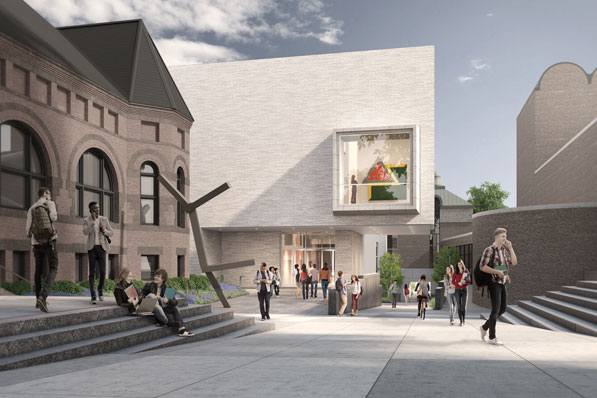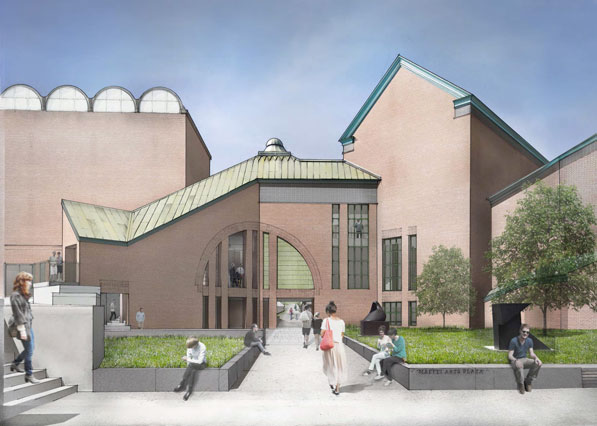
- About
- Departments
- Construction on Campus
- Service Requests
Back to Top Nav
Back to Top Nav
Work is set to begin this spring on a $50 million expansion and renovation of the Hood Museum of Art.

Artist rendering of the north façade of expanded Hood Museum of Art. (Image courtesy of Tod Williams Billie Tsien Architects)
Plans call for the creation of a prominent gray- and white-brick façade facing the Green that will proclaim the Hood’s presence on campus; a new Center for Object-Based Inquiry that will triple the museum’s capacity to fulfill its teaching mission; 40 percent more gallery space; and a flexible concourse that will be a new venue for gatherings and performances.
Timeline
Winter 2016
Museum open
Two exhibitions: Eric Aho Ice Cuts series; and Inventory: New Works and Conversations around African ArtMid-March–July 2016
Museum empties
Construction site fencing and staging constructedAugust 2016–December 2018
ConstructionWinter 2018–Summer 2018
Acclimatization to ready museum for art to be returned to the buildingSummer–Fall 2018
Art returns to the finished buildingWinter 2019
Grand opening
In short, the Hood is being fully reimagined by National Medal of the Arts-winning architects Tod Williams and Billie Tsien to meet the museum’s 21st-century needs. At the same time, the renovation will complement architect Charles Moore’s award-winning 1985 design, which was funded by a bequest from Harvey P. Hood, a former trustee and member of the class of 1918.
“The Hood has been a jewel at the heart of the Dartmouth campus for 30 years,” says Provost Carolyn Dever. “By putting learning at its core, this expansion will help drive what it means to have a teaching museum on an academic campus in the 21st century.”
The Hood expansion is part of the Arts and Innovation District on campus, which includes the Black Family Visual Arts Center, the DEN Innovation Center and New Venture Incubator, and the Hopkins Center for the Arts.
While the museum is under construction, John Stomberg, who next month begins work as the Virginia Rice Kelsey 1961s Director of the Hood, says, “The Hood will continue to be part of campus life. I’m eager for us to have an active, noticeable presence during this time. We won’t go dark.”
Read more about how the Hood will be engaging the public during the construction period.
“I think of Billie Tsien and Tod Williams as poets. They are to architecture what Emily Dickinson is to words,” says Stomberg. “They create emotive spaces that shape experience in a beautiful way.”
Read more:
The Hood: ‘Fully Engaged’ Throughout Construction
John Stomberg to Direct the Hood Museum of Art
Williams and Tsien, a husband-and-wife team whose firm is based in New York City, have designed several important museums, including the Barnes Foundation building in Philadelphia.
“The project at the Hood is different in that we are working with a building that has a complex and idiosyncratic character,” says Tsien, who studied with Charles Moore at UCLA. “We want to honor and enhance this character while at the same time creating a sense of calm and order.”
The project is also unique, she says, because of the Hood’s teaching mission. “In a traditional museum the ‘hands-off’ policy is firmly in place. In a teaching museum, the connection to the work is much more intimate. In many ways, we are trying to encourage a sense of curiosity by as much direct contact as possible.”
The expanded Hood will facilitate a number of things the current building can’t. For example, the new Center for Object-Based Inquiry will allow students and faculty opportunities for close study of objects in the collections as never before.
“It’s just a dream-come-true teaching space,” says Stomberg of the center, which will feature three classrooms, including one dedicated to studying works on paper. Each of the classrooms will be equipped with technology to allow students and faculty to compare works and teleconference with specialists anywhere in the world.Stomberg calls the center’s classrooms “probably the best teaching spaces in the country for object-based learning. Our core mission will be fulfilled in a way that every other museum dreams of doing.”
In addition, five new galleries will allow the museum to display more of the collection, and the original 10 galleries will be updated and refurbished. “The overall vision is that the Hood is a place where the you always find something new,” Stomberg says.
Another key feature: an entrance atrium, connected to the Hop, that can be used for a variety of performances and gatherings and will make the Hood as much a social space as a center for teaching, learning, and viewing art.
“The entrance will help tip the hat, architecturally, to say this is a vital place—things are happening here,” Stomberg says.
The expansion is being built in a very tight space, says Lisa Hogarty, vice president of Campus Services, and the community can expect some disruption during the planned 18 months of construction.
“We’ve been telling faculty, staff, and students who use Wilson Hall and the Hopkins Center for the Arts that we will do everything we can to mitigate noise and movement and vibrations,” she says.
During the construction period, Hogarty’s team will provide frequent updates as well as detour suggestions around the construction to get to the south end of campus. “We will mainly direct people to go through the Hop or around the steam plant,” she says.
Though the physical structure is expected to be complete in the winter of 2018, the museum itself will not be ready to open for another year—not until the staff is satisfied that the building’s climate-control systems work perfectly through New Hampshire’s seasonal changes.
“People are going to say, ‘Hey the museum is done, why isn’t it opening?’ But the answer will be that it just looks done—it’s actually not until we can prove that we can maintain museum conditions,” says the Hood’s interim director, Juliette Bianco ’94.
Once this acclimatization process is complete, the staff will begin to move art back into the museum in the summer of 2018, a process that will take approximately six months.
Although the new facility will be half again as large—adding more than 20,000 square feet—as the original building, it will use about 10 percent less energy, says Hogarty.

Artist rendering of the south façade of expanded Hood Museum of Art. (Image courtesy of Tod Williams Billie Tsien Architects)
“The original building is one of our major energy hogs,” says Hogarty. “We focused on how to make the new building as energy efficient as possible.”
Managing winter snow load has been a chronic issue for the existing building—a challenge campus planners put to the architects. “We said, ‘Imagine this building was only built for February—how would you design it?’ They have solved every single problem,” says Hogarty.
And they’ve done it while keeping the core of Moore’s design, Hogarty says. “The last real challenging snow area is the cupola over the main entry. The solution is we’re going to take the copper roof off, put in heating elements underneath to melt the snow, redo the gutter and drainage system, and then they’ll restore it perfectly so that the architecture of that building is intact.”
Plans also call for reclaiming heat from the steam lines running between Wheelock Street and the Maffei Arts Plaza to melt snow and drain water quickly from the walkway. “That should be one of the nicest spaces on campus to walk into in February,” Hogarty says.
The passageway from Wheelock Street to the Maffei Plaza will be wider than the current passage, Hogarty says. “We’re going to complete the Charles Moore arch, opening it up to about nine feet wide. It will feel much more inviting. We want people to come through to Lebanon Street to get to the DEN and this part of campus.”
The Arts and Innovation District will be much more visible “from both sides, from the Green as well as from Lebanon Street,” she says.
Throughout the design process, the architects “have been incredible partners,” says Hogarty. “They love this project, and they are unbelievable problem-solvers for every challenge we put in front of them.”
“We are thrilled to be working on a project that will help to change the way people see the world,” says Tsien. “Dartmouth students will be forever changed by their experiences in the new museum.”